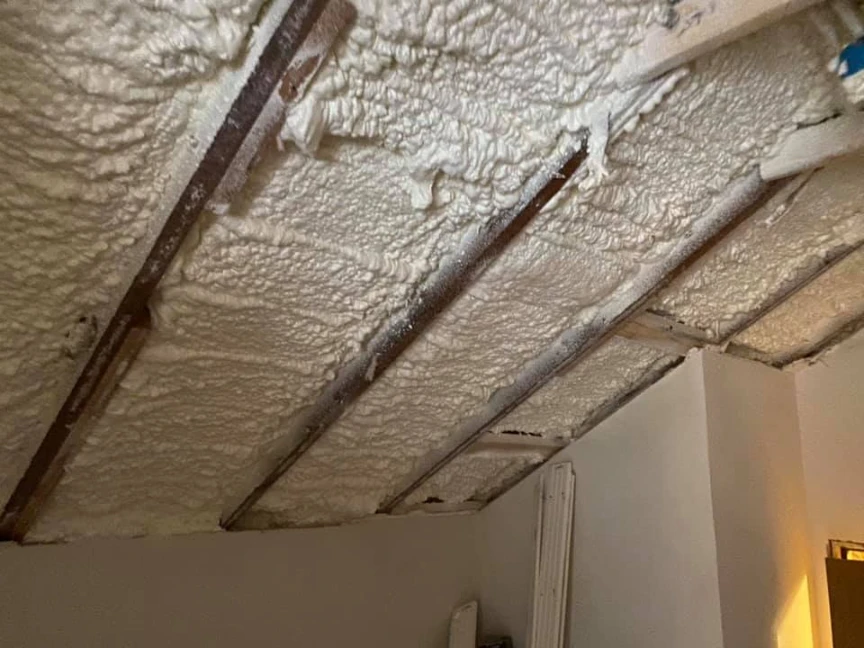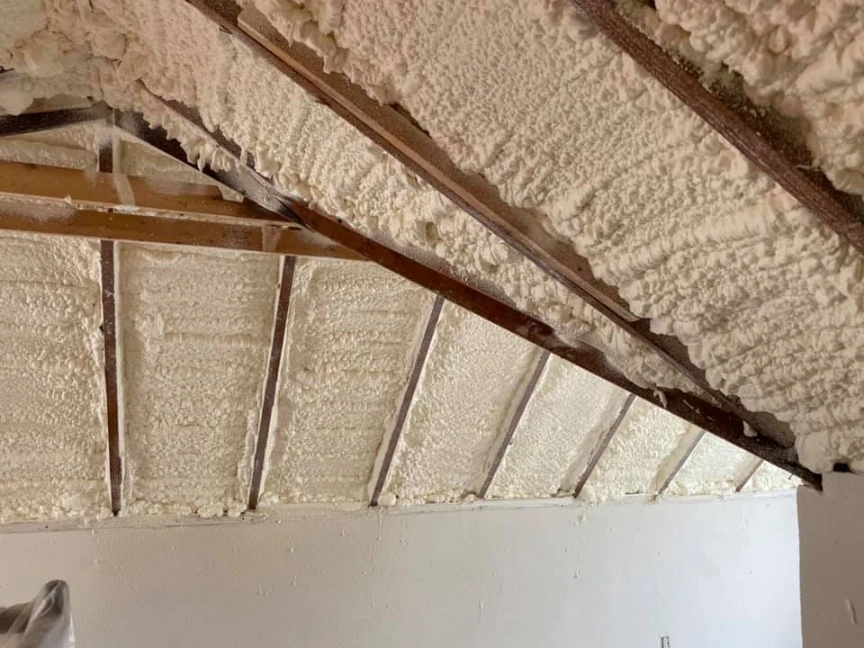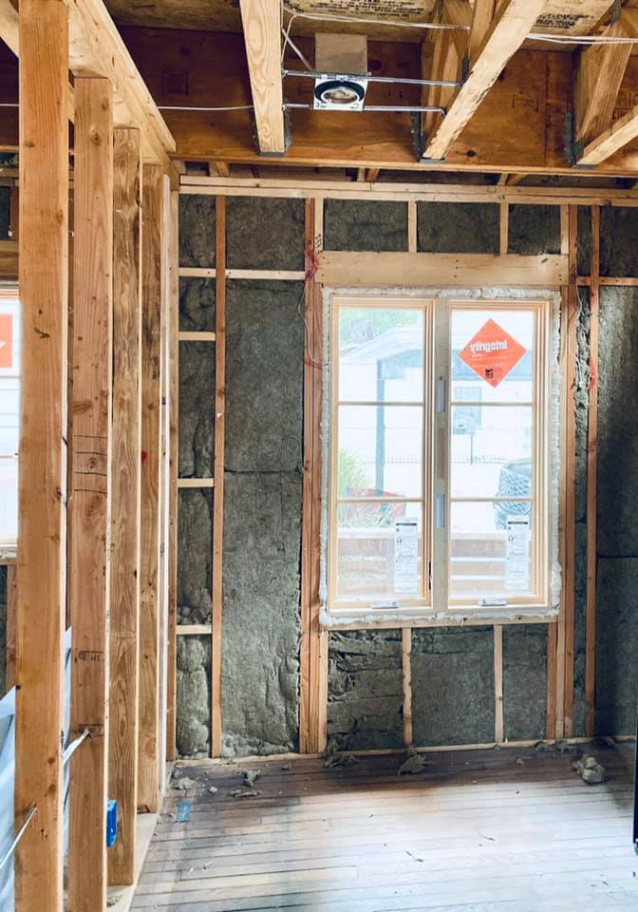Crawlspace insulation is highly effective at blocking outdoor noise, but its performance depends entirely on the type of material used. While all insulation provides some sound reduction, materials with higher density and air-sealing properties offer a significant acoustic barrier against everything from low-frequency traffic to high-frequency noises. Based on extensive field experience, this practical guide explains how different insulation materials block sound, what factors influence their effectiveness, and what to consider before making a decision to achieve a quieter home.
How Sound Enters Through a Crawlspace
An uninsulated or poorly insulated crawlspace can act like an amplifier for outdoor sounds, transmitting them directly into the home above. Sound travels in two primary ways: through the air and through solid structures.
- Airborne Sound: This is what most people think of as noise. It includes sounds like cars driving by, people talking, and dogs barking. Airborne sound waves travel through the air and can easily pass through any gaps, cracks, or vents in a home’s foundation. An unsealed crawlspace with open vents is a direct pathway for this type of noise to enter.
- Structure-Borne Sound: This type of sound travels as vibrations through solid materials. For example, the low-frequency rumble from a heavy truck or nearby construction can vibrate the ground, travel through the foundation, and move up into the floor joists of your home. The floor then radiates this vibration as audible sound into your living area.
Without insulation, the hollow cavity of the crawlspace does little to stop either type of sound. Insulating the area addresses both pathways by absorbing sound waves and creating a barrier that dampens vibrations.
Comparing Insulation Materials for Sound Reduction
Not all insulation is created equal when it comes to acoustics. The material’s density, structure, and method of application all determine how well it blocks noise. Some materials are designed almost exclusively for thermal performance, while others excel at both thermal and acoustic control. A study from the U.S. Department of Energy outlines the different types of insulation, though their primary focus is on thermal properties.
The table below compares common crawlspace insulation materials based on their sound-blocking abilities.
| Insulation Type | Primary Function | Sound Blocking Ability | Key Characteristics |
|---|---|---|---|
| Mineral Wool | Thermal & Acoustic | Excellent | High density and non-directional fibers trap sound waves effectively. Also fire-resistant. |
| Open-Cell Spray Foam | Thermal & Acoustic | Very Good | Soft, pliable cells absorb mid to high-frequency sounds like voices and televisions. Excellent air seal. |
| Closed-Cell Spray Foam | Thermal & Moisture | Good | Rigid, dense structure is effective at blocking low-frequency noise and dampening vibrations. Acts as a vapor barrier. |
| Fiberglass Batts | Thermal | Fair | Low density makes it less effective for sound. Can help with some high frequencies but does little for traffic noise. |
| Rigid Foam Board | Thermal | Poor to Fair | Stiff panels reflect sound rather than absorb it. Primarily used for thermal breaks, not acoustics. |
Mineral Wool Insulation
Also known as Rockwool, mineral wool is a top performer for sound reduction. It’s made from stone and slag that is melted and spun into a dense, fibrous mat. This dense structure is incredibly effective at trapping sound waves and stopping them from passing through. Its non-directional fiber layout makes it particularly good at absorbing a wide range of frequencies.
Spray Foam Insulation
Spray foam is unique because it expands to fill every crack and crevice, creating a continuous air seal. This air barrier is critical for stopping airborne sound.
- Open-Cell Foam: This type of spray foam has a soft, sponge-like texture. It’s fantastic at absorbing sound waves, making it a great choice for reducing mid and high-frequency noise.
- Closed-Cell Foam: This foam is rigid and dense. While its sound absorption isn’t as high as open-cell, its density and rigidity are very effective at blocking the transmission of low-frequency sounds and dampening structure-borne vibrations. According to data from the Spray Polyurethane Foam Alliance, closed-cell foam’s rigidity also adds structural strength to the surfaces it’s applied to.
Bonus Tip: For the best of both worlds, some installations use a “flash and batt” system. A thin layer of closed-cell spray foam is applied to air seal the area, followed by a thick batt of mineral wool to provide maximum sound absorption.
Things to Consider Before Making a Decision
Before selecting an insulation material, it’s important to assess your specific situation. The right choice depends on the type of noise you’re trying to block, the condition of your crawlspace, and your budget.
Identify the Type of Noise
What kind of sound is bothering you?
- High-Frequency Noise: Voices, birds, and lighter traffic sounds are easier to absorb. Open-cell spray foam or mineral wool works well.
- Low-Frequency Noise: The deep rumble from highways, airplanes, or industrial equipment is harder to block. This requires a dense, heavy material like closed-cell spray foam or mineral wool.

Analyze Your Crawlspace Condition
The physical state of your crawlspace will influence your options.
- Vented vs. Unvented: Traditional vented crawlspaces are major entry points for noise. Insulating these requires a strategy that often involves sealing the vents, which is part of creating an encapsulated crawlspace. Research from the Building America Solution Center shows that sealed crawlspaces perform better in terms of energy efficiency and moisture control, which also improves acoustic performance by eliminating direct sound paths.
- Moisture Levels: A damp or wet crawlspace can lead to mold and rot. Closed-cell spray foam is a great option here because it acts as a vapor barrier and is waterproof. Mineral wool is also moisture-resistant, while fiberglass can hold moisture and lose its effectiveness.
Bonus Tip: When sealing crawlspace vents, use a solid, airtight material like rigid foam board cut to size and sealed in place with caulk or foam. Simply stuffing them with fiberglass won’t stop air or sound effectively.
Budget and Performance Goals
There’s a direct relationship between cost and performance. Fiberglass batts are the least expensive option but offer minimal acoustic benefits. Mineral wool provides excellent sound control at a mid-range price point. Spray foam is typically the most expensive but offers superior air sealing and both thermal and acoustic performance, making it a comprehensive solution.
Frequently Asked Questions
What is the best insulation for soundproofing a crawlspace?
For pure soundproofing performance, mineral wool is often considered the best due to its exceptional density and sound-absorbing properties. Open-cell spray foam is a close second, offering the added benefit of a perfect air seal.
Will insulating the crawlspace completely soundproof my home?
No, crawlspace insulation is just one piece of the puzzle. Sound can also enter through walls, windows, doors, and the roof. While it will significantly reduce noise coming from below, it won’t create a completely silent environment on its own.
How does crawlspace encapsulation help with noise?
Yes, absolutely. A core part of encapsulation is air sealing the foundation walls and vents. This process eliminates the direct pathways for airborne sound to enter, making it one of the most effective ways to reduce noise from the crawlspace.
What should be done with crawlspace vents?
Crawlspace vents are essentially open windows for sound. For any serious noise reduction effort, these vents should be sealed. This is a standard step in crawlspace encapsulation, where the entire space is sealed off from the outside air.
Can I add new insulation over my old crawlspace insulation?
It’s generally not a good idea. Old insulation, especially if it’s sagging, wet, or infested with pests, should be removed completely. Installing new material over it can trap moisture, hide potential structural issues, and reduce the effectiveness of the new insulation.
How much does soundproofing crawlspace insulation cost?
Costs vary widely based on the material chosen, the size and condition of the crawlspace, and labor rates. Fiberglass is the most affordable, mineral wool is in the middle, and spray foam is the premium option. The investment often pays off in both comfort and energy savings.
Final Thoughts on a Quieter Home
While crawlspace insulation is primarily installed for energy efficiency and moisture control, its role in blocking outdoor noise is a powerful secondary benefit. By choosing a material with high density and excellent air-sealing capabilities, you can create a quieter, more peaceful living environment. Before moving forward, carefully evaluate the specific noise problem you’re facing, the current state of your crawlspace, and your long-term performance goals.
Click here to read more and stay informed about Stellrr Insulation & Spray Foam’s latest innovations in crawl space solutions.
Contact Us for an Assessment
If you’re unsure which solution is right for your home, a professional evaluation can provide clarity. The team at Stellrr Insulation & Spray Foam is available to inspect your crawlspace and recommend the most effective approach for your needs. For more information or to schedule a consultation, you can reach out via email at info@stellrr.com or call (512) 710-2839. A properly insulated home is not just more efficient; it’s also a more comfortable and quiet place to live.
Sources
- U.S. Department of Energy – Provides an overview of different insulation types and their primary applications in residential buildings.
- Spray Polyurethane Foam Alliance – Offers technical data and answers to common questions about both open-cell and closed-cell spray foam products.
- Building America Solution Center – Details the benefits and construction methods for creating sealed, unvented crawlspaces, a strategy that improves thermal, moisture, and acoustic performance.





